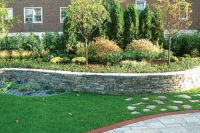A lot has changed in the roofing industry since black EPDM single-ply roofing membrane was introduced in the early 1960s; countless products, installation methods, and design practices have come and gone. One thing that hasn’t changed is the general consensus that the best roof is one that doesn’t leak and lasts a long time. That’s why today, after more than 50 years since its introduction, many construction professionals are seeing the benefits of black EPDM in a whole new light.
Durability
Black EPDM roofing systems have been time-tested for more than 50 years and have proven to be extremely durable, often lasting more than 30 years. Testing of 30-year-old EPDM has shown that many of its physical properties meet or exceed ASTM standards. A long-term weathering study cited by the EPDM Roofing Association (ERA) examined five roofing systems, all with 28 to 32 years of in-field service, and concluded that the systems were not only performing up to industry standards, but in some cases performing with physical properties that exceeded those of newly-produced EPDM membranes.
UV Resistance
UV resistance is another category in which EPDM outperforms other popular commercial roofing materials. Comparative ASTM weathering test data on various 1.5-mm (60-mil) membranes clearly indicates non-reinforced black EPDM can survive the most severe exposures to UV, going well beyond the industry’s minimum standard. When subjected to Xenon-arc testing (the industry standard for comparing how long a particular roofing material will resist cracking or crazing from UV exposure), non-reinforced black EPDM was the clear winner.
Hail Resistance
Empirical data and scientific testing show that non-reinforced black EPDM provides excellent protection against severe weather, including extreme temperatures and hail, making EPDM roofing systems well-suited to a wide variety of geographic areas. Asphalt-based roofing products and white plastic-based membranes have a tendency to become more brittle with age, and therefore more vulnerable to hail damage. The same is not true of EPDM, which provides a Class 4 impact resistance rating under UL Standard 2218; achieves FM’s Severe Hail rating; and passes the National Bureau of Standards’ #23 Ice Ball Test up to 3” diameter hail.
A 2009 report prepared by roof consultants Jim Koontz and Tom Hutchinson states, “The results of this research clearly indicate that non-reinforced EPDM…offers a high degree of hail resistance…field and heat aged EPDM membrane… retains the bulk of its impact resistance as it ages.” In a 15-page report prepared for ERA in 2007, Ric Vitiello of Benchmark Services commented, “Based on field and test data, it is clear EPDM outperforms other roof systems,” and also stated, “EPDM systems are much more hail-resistant, even without special treatment.”
Resistant to Extreme Temperatures
Black EPDM also provides unparalleled resistance to temperature extremes. Properly designed EPDM roofs will expand and contract along with temperature changes, making them ideal for a wide variety of climates and geographical locations. EPDM is the most dimensionally stable single-ply roofing membrane, remaining flexible even in very cold weather; per ASTM D5279-08, EPDM is more flexible at 0°F than TPO at 100°F. When subjected to accelerated heat aging per ASTM D573, EPDM lasted 68 weeks at 240°F before the test was stopped, proving its suitability for hot climates as well as cold.
Increased Protection and Ease of Repair
White thermoplastic TPO and PVC membranes require an internal reinforcing scrim and only have 20-25 mils of weathering material over the reinforcing scrim in a 60-mil membrane. Comparatively, non-reinforced EPDM membranes have no scrim, and therefore provide a full 60 mils of weathering material. Reinforced membranes must be replaced once the reinforcing scrim is showing through, but non-reinforced EPDM is easily repairable, even at the end of its service life.
More Black Benefits
EPDM’s dark-colored surface helps to melt the frost, dew, and ice that can create slippery conditions on the rooftop. Black EPDM membrane also helps to reduce snow load and dries much more quickly than a reflective roof. In addition, the solar thermal benefits of black EPDM help to reduce the potential for condensation issues in the roofing assembly, which can negatively affect the performance of paper insulation facers, weaken the bond between insulation and adhesive, and lead to “mystery leaks” in the spring.
Conclusion
After 50-plus years in the field, non-reinforced black EPDM has an excellent track record of superior performance and quality. It has provided countless building owners with long-lasting, reliable roof systems. EPDM’s durability, thermal benefits, and resistance to UV, extreme temperatures, and hail damage make it an ideal choice for almost any commercial roofing project.






Report Abusive Comment